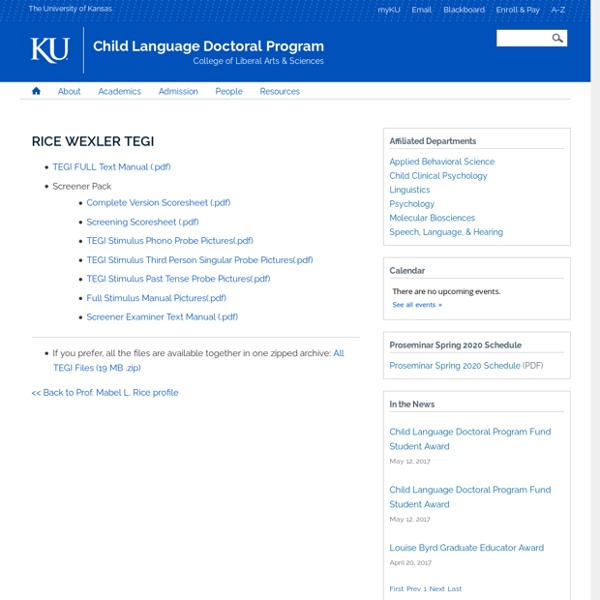Brown's Stages of Syntactic and Morphological Development
Brown's Stages of Syntactic and Morphological Development Details Created: Wednesday, 09 November 2011 08:53 Updated on Thursday, 07 November 2019 17:13 Typical expressive language development
The Rossetti Infant-Toddler Language Scale
Purpose: Designed to provide the clinician with a comprehensive, easy-to-administer, and relevant tool to assess the preverbal and verbal aspects of communication and interaction in the young child.Ages: Birth to 3 years; Grades: Birth-PreKAdministration Time: Will vary Description: The Rossetti-Toddler Language Scale is a criterion referenced instrument that assesses Interaction-Attachment, Pragmatics, Gesture, Play, Language Comprehension, and Language Expression. Behaviors can be directly elicited from the child, directly observed, or reported by parent or caregiver to credit the child's performance. All carry equal weight when scoring the Scale. Results reflect the child's mastery of skills in each of the areas assessed at three-month intervals across developmental domains tested. The test items guide you in directing and structuring observations observations in order to monitor the child's progress in language developmental areas.
Multicultural Considerations
Clerc Center » Info to Go » Multicultural Considerations This section of Info to Go includes resources related to multicultural considerations for students and their families, as well as links to resources in languages other than English. Clerc Center Resources Odyssey: New Directions in Deaf Education (Annual magazine published by the Clerc Center)
PEARL – A Universal Kindergarten Screener for Dyslexia – Language Dynamics Group
The PEARL is a dyslexia screener that accurately identify future decoding and comprehension difficulty in minutes! What is included in the PEARL Screener: PEARL Screener Examiner’s ManualPEARL Screener Stimulus Book (User Options: 1 Stimulus book/1 User, 3 Stimulus Books/3 Users, 5 Stimulus Books/5 Users) PEARL Screener Protocols (25 included) Additional protocols available to purchase PEARL Carrying Bag Highlights of the PEARL Screener Only takes 5-15 minutes to administer (in majority of cases)Accurately predicts future decoding and comprehension difficulty with 80% (or higher) sensitivity and specificityReduces cultural and linguistic bias with 80% (or higher) sensitivity and specificityInforms present level of decoding and academically related language abilityThe PEARL can be administered by anyone who can read and understand the test manual and has knowledge of standardized assessment procedures
Intelligibility in Context Scale - Multilingual Children's Speech
The Intelligibility in Context Scale is a quick parent report measure of children's intelligibility. The 7-item questionnaire rates the degree to which children's speech is understood by different communication partners (parents, immediate family, extended family, friends, acquaintances, teachers, and strangers) on a 5-point scale. It has been developed to provide speech-language pathologists with information about children's intelligibility (e.g., children with speech sound disorders, childhood apraxia of speech).
Words Their Way – Explorations in Literacy
Since my first year teaching in 2012, we have used Words Their Way to teach spelling. If you aren’t familiar with the program, we start by giving students a spelling inventory. This assessment places them in a spelling stage, and we begin giving them word lists based on their level. We have really improved our practices over the years with the program.
Readers Theatre
Home › Classroom Resources › Lesson Plans Lesson Plan Overview Featured Resources
Stages of Language Development Checklist - Kid Sense Child Development
< Back to Child Development Checklists Instructions: Answer all questions up to your child’s current age bracket by answering ‘Yes’ or ‘No’. Interpretation: If you tick 2 or more boxes with a ‘Yes’ contact Kid Sense Child Development on 1800 KIDSENSE (1800 543 736). Does your child have difficulty with: This checklist was designed to serve as a functional screening of developmental skills per age group.
Addressing ELLs’ Language Learning and Special Education Needs: Questions and Considerations
"We worry about what a child will be tomorrow but we forget that he is someone today." — Karl Meninger Samira's Story A number of years ago, Kristina taught a Somali English language learner (ELL) named Samira who was dedicated, attentive, and friendly. Kristina thoroughly enjoyed teaching her as they worked on Samira's English skills. When it came to assigning final grades, though, Kristina had a dilemma – Samira wasn't able to successfully complete assignments. She came to the classroom often, asked for additional help, and did her best to understand the directions and complete the work.
Response to Intervention / Vocabulary
Tier 1 Classwide, Whole Group Intervention Vocabulary Journal Vocabulary Cards
AAC Interventions to Maximize Language Development for Young Children
You are viewing the website for the aac-rerc, which was funded by NIDRR from 2008-2013. For information on the new RERC on AAC, funded by NIDILRR from 2014-2019, please visit rerc-aac.psu.edu. AAC Interventions to Maximize Language Development for Young Children Click here to view the webcast in Adobe Presenter



